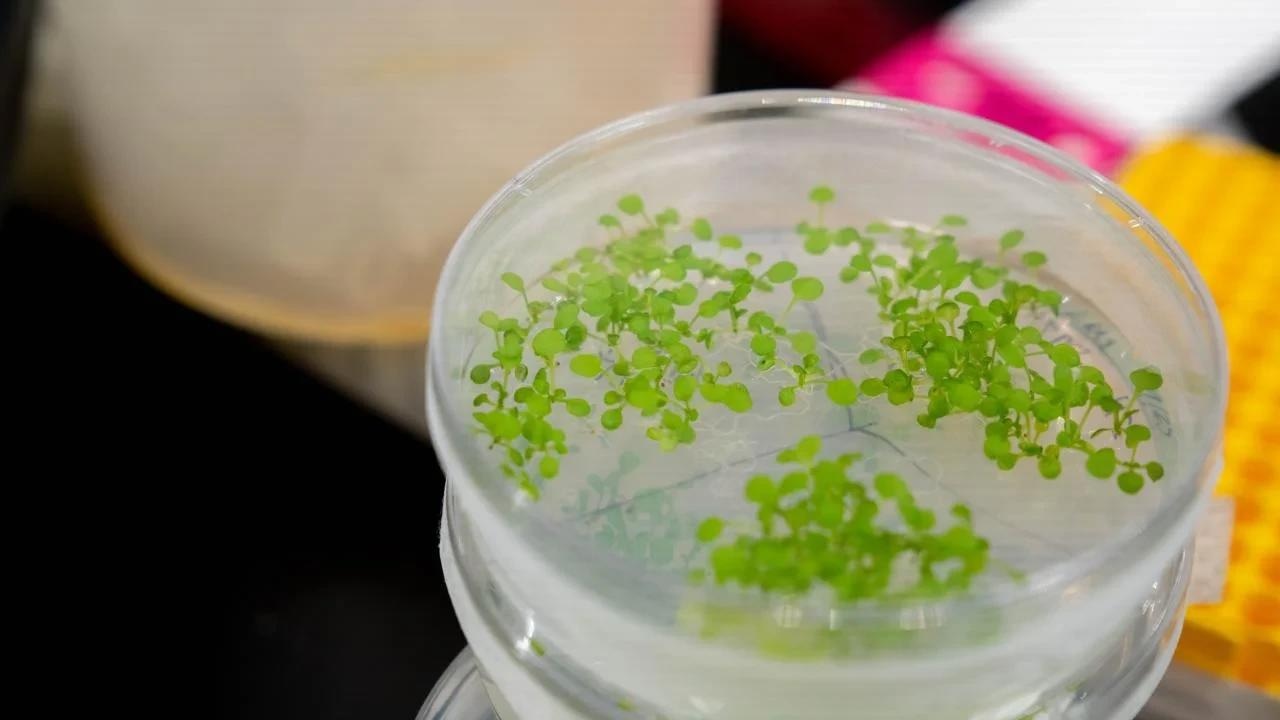Reviewed by Danielle Ellis, B.Sc.Oct 26 2023
For a long period, scientists have been aware of chloroplasts' role in converting solar energy into plant food. However, a recent research project, spearheaded by plant biologists from the University of California, Davis, has revealed that chloroplasts are also indispensable for a plant’s defense against viral and bacterial pathogens.
 Experimental seedlings in the laboratory. UC Davis plant biologists have discovered how chloroplasts, responsible for photosynthesis in green plants, also play a key role in plant immunity to infections. Image Credit: Sasha Bakhter/UC Davis College of Biological Sciences.
Experimental seedlings in the laboratory. UC Davis plant biologists have discovered how chloroplasts, responsible for photosynthesis in green plants, also play a key role in plant immunity to infections. Image Credit: Sasha Bakhter/UC Davis College of Biological Sciences.
Chloroplasts are typically spherical in shape, yet a small portion of them undergo a transformation, giving rise to slender projections known as “stromules.” These stromules were first documented more than a century ago, but their biological purpose has remained shrouded in mystery.
Prior investigations have demonstrated that when a plant detects an infection, chloroplasts increase their production of stromules. These stromules serve to congregate chloroplasts around the nucleus and act as conduits for conveying pro-defense signals from chloroplasts to the nucleus.
However, researchers have thus far been unable to ascertain the specific role of stromules in plant immunity, as they have yet to identify any genes responsible for stromule formation.
The recent investigation, led by Professor and Department of Plant Biology Chair, Savithramma Dinesh-Kumar, alongside graduate student Nathan Meier and their team, has successfully pinpointed a pivotal protein associated with the formation of stromules in the context of plant immunity. Their discoveries have been published in the October 25th issue of Science Advances.
A Hidden Player in Immune Defense
To analyze the role of stromules in immunity, researchers needed to deactivate them and then observe how plant cells lacking stromules respond when exposed to a pathogen. However, because the genes responsible for stromule formation remained unidentified, researchers faced a challenge in knowing which genes to deactivate.
To overcome this obstacle, Dinesh-Kumar and his team turned their attention to kinesins, which are proteins functioning as minuscule motors facilitating the movement of molecules and organelles within a cell.
This intracellular movement typically involves the cell's cytoskeleton, comprised of two distinct types of fibers: the larger microtubules and the smaller actin filaments.
The scientists aimed to explore a plant-specific kinesin variant with the ability to bind both microtubules and actin filaments. They discovered that elevating the expression of a particular kinesin, KIS1 led to the creation of stromules even in the absence of pathogen infection.
In their experiments involving tobacco and Arabidopsis plants, where they inhibited the production of the KIS1 kinesin, the results were noteworthy. Both plant species were incapable of generating stromules, and their chloroplasts did not relocate toward the nucleus. Consequently, these plants were rendered defenseless against introduced pathogens.
Secrets of Chloroplast Movement
To unravel the distinct functions of microtubules and actin, the scientists engineered two sets of KIS1 variants: one that exclusively interacted with microtubules and another that exclusively bound to actin.
When these variants were expressed in tobacco plants, it became evident that for chloroplasts to generate stromules, KIS1 had to bind to microtubules. However, for chloroplasts to relocate towards the nucleus, KIS1 also needed to interact with actin.
The research team was also keen on understanding the broader role of stromules in the context of plant immunity. Through genetic manipulation to deactivate different immune signals, they determined that stromule formation is triggered by molecular signaling. Furthermore, they established that an intact immune signaling system is a prerequisite for stromules to develop.
If we remove any of the known immune signaling genes, the chloroplasts lose the ability to make stromules, which suggests that these structures are an integral part of the immune signaling pathways that activate defense.”
Savithramma Dinesh-Kumar, Professor and Chair, Department of Plant Biology, University of California-Davis
New Light on Plant Immunity
This research marks the initial documentation of a plant kinesin directly engaged in plant immunity.
Additionally, it represents the maiden identification of a gene, KIS1, linked to the creation of chloroplast stromules. This discovery paves the way for comprehending the functions of chloroplast stromules and the reasons behind the clustering of chloroplasts around the nucleus during the plant’s immune defense.
If we can better understand at the cellular level how organelles like chloroplasts help cells to defend themselves, we could help to engineer resistance to the pathogen.”
Savithramma Dinesh-Kumar, Professor and Chair, Department of Plant Biology, University of California-Davis
Source:
Journal reference:
Meier, N. D., et al. (2023) Calponin homology domain containing kinesin, KIS1, regulates chloroplast stromule formation and immunity. Science Advances. doi.org/10.1126/sciadv.adi7407